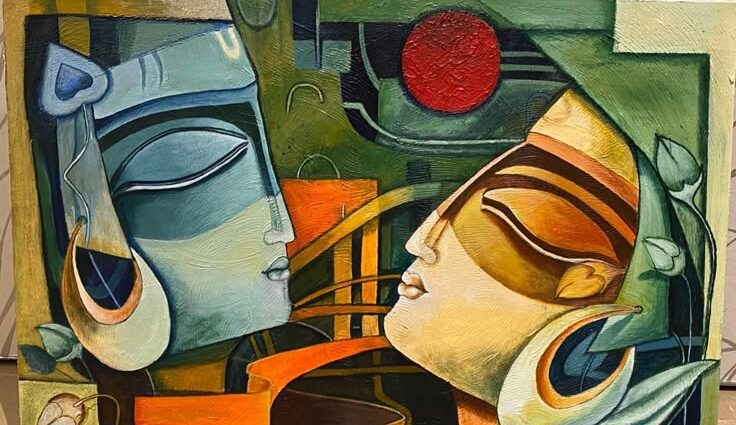This painting is a beautiful example of modern abstract art with strong influences from traditional Indian aesthetics, particularly those found in depictions of divine or mythological figures. Let’s break down the composition, color palette, symbolism, and overall impression:
Composition & Figures:
- Dual Figures:
The painting features two stylized human faces, gazing at each other with closed eyes. The composition is symmetrical in its subject matter but dynamic in layout, suggesting a deep connection or intimacy between the figures. This could symbolize love, unity, or spiritual balance. - Masculine & Feminine Elements:
The figure on the left, with blue-green tones and a calm demeanor, may represent a masculine archetype—potentially inspired by depictions of Lord Krishna or Shiva. The figure on the right, in warm earthy tones with a serene expression, appears more feminine, possibly symbolizing Radha or Parvati. This duality can reflect the yin and yang balance in relationships or cosmic unity. - Earrings and Headdresses:
Both figures are adorned with large, circular earrings and head coverings or crowns, adding a regal or divine quality to them. The earrings are rendered in bold, smooth brushstrokes, emphasizing ornamentation and perhaps the cultural importance of jewelry in Indian art.
Color Palette:
- Cool vs Warm Tones:
- The left side uses cool blues, teals, and aquamarine shades to convey calmness and peace.
- The right side employs warmer tones like amber, ochre, brown, and gold to evoke passion, warmth, and grounding.
- Together, the colors create a visual and emotional balance, echoing the theme of duality and harmony.
- Background Details:
The background is a rich combination of deep green, red, orange, and geometric lines. There’s a bright red circle near the top center, possibly symbolizing the sun or a bindu (cosmic point) in Hindu-Buddhist traditions—often representing the source of creation or the soul.
Style & Technique:
- Cubist Influence:
The fragmented, angular sections of the painting and stylized features suggest a cubist or semi-abstract style. Lines, shapes, and blocks of color dominate rather than realistic representation. - Textural Elements:
The brushstrokes are visible and bold, especially in the red sun and some areas of the background, giving the painting texture and depth. - Nature Motifs:
Leaves and natural forms are subtly integrated into the composition—seen on the earrings, headdresses, and background—adding a spiritual, earth-connected element.
Symbolism & Interpretation:
- Divine Union:
The painting can be interpreted as representing a spiritual or cosmic union, like that of Radha-Krishna, Shiva-Parvati, or simply the sacred masculine and feminine. - Inner Peace and Connection:
The closed eyes and tranquil expressions suggest introspection, meditation, or inner peace, rather than physical interaction. It’s about connection beyond the material. - Balance of Opposites:
Light and dark, warm and cool, male and female—all are harmonized here, reinforcing the theme of balance and unity.
Overall Impression:
This painting evokes a serene, contemplative mood, with layers of cultural symbolism and spiritual depth. It’s a striking blend of traditional Indian art motifs with modern abstraction, using form and color to communicate emotion, connection, and transcendence.
